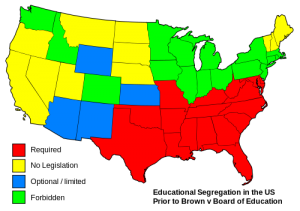Two weeks from now marks the 60th anniversary of a very special day in United States history. On May 17, 1954, the Supreme Court in an unaminous decision declared state laws establishing separate public schools for black and white students unconstitutional. The decision overturned Plessy v Ferguson, an 1896 decision that allowed state-sponsored segregation, insofar as it applied to public education. The 1954 decision, Brown v Board of Education, stated that “separate educational facilities are inherently unequal.” This decision marked the beginning of the civil rights movement in the United States.
The ruling wasn’t universally liked, or followed for that matter. In 1957, Governor Orval Faubus deployed the Arkansas National Guard to assist segregationists in blocking nine black students from entering an all white high school in Little Rock. Twenty days later, President Eisenhower ordered the 101st Airborne Division to Little Rock to protect the students, and federalized the entire Arkansas National Guard, thus taking them out of the hands of Faubus. In a speech broadcast on nationwide television and radio, Eisenhower stated that when the decrees of a Federal court were obstructed, “the law and the national interest demanded that the President take action.”
The same year, the Florida legislature passed an Interposition Resolution declaring the decision null and void, but Governor LeRoy Collins refused to sign it. In 1962, both the Mississippi Governor and Lieutenant Governor were arrested and charhed with contempt for their part in blocking James Meredith’s entry to the University of Mississippi. Robert Kennedy as the U. S. Attorney General eventually sent 500 Marines in to stop the segregationists who were rioting. In 1963, Alabama Governor George Wallace personally blocked the door to Foster Auditorium to prevent two black students from enrolling. Plus, there were many examples of such animosity towards the law in other cities and towns.
So, it’s 60 years later, and how far have we come? In 1963, about 1 percent of black children in the South attended school with white children. By the early 1970s, 90 percent of black children attended desegregated schools, due to court oreder and aggressive policing by federal agencies who had the power to withhold federal money from districts who refused to desegregate. However, in recent years, this has been changing, and not in a positive way.
A recent study by ProPublica found that “officials in scores of school districts do not know the status of their desegregation orders, have never read them, or erroneously believe that orders have been ended. In many cases, orders have gone unmonitored, sometimes for decades, by the federal agencies charged with enforcing them.” At the height of court enforced integration, there were 750 school districts known to be under desegregation orders. Today, there’s more than 300 under orders, with some being due to judges determining that they haven’t fully complied.
How did we get to this point? The courts. According to ProPublica, some federal courts don’t even know how many desegregation orders still exist on their dockets. There’s also been an increasing number of cases where federal judges release districts from court oversight even where segregation prevails, at times taking the lack of action in cases as evidence that there aren’t any issues. In 1972, only about 25 percent of black students in the South attended schools in which at least nine out of 10 students were racial minorities, due to the federal policing. In districts released from desegregation orders between 1990 and 2011, 53 percent of black students now attend such schools,
Then there’s the Supreme Court. Since the 1990s, the Supreme Court has limited the power of parents to challenge racial inequities in schools. Districts not under court orders are prohibited from using race as a consideration to balance schools.
There’s also the lack of funding to enforce the laws that stand. Ronald Reagan, upon taking office in 1981, immediately cut federal financial support for desegregation efforts. Reagan’s head of the Justice Department’s civil rights division, William Bradford Reynolds, said the department would not “compel children who do not want to choose to have an integrated education to have one.” The process further accelerated under George H.W. Bush.
In an article in The Atlantic called Segregation Now, Nikole Hannah-Jones discusses the Tuscaloosa, Alabama school system and tells the story of Central High School. Central High School came about from a 1979 order by a federal judge to combine two segregated high schools into one large integrated school. By the end of the 1980s, Central High School was a shining example of what integration could achieve, with both academic excellence and good sports teams. But, in 2000, a federal judge released the Tuscaloosa school system from its court-ordered desegregation mandate, claiming the job was done. Freed from the court orders, the one large diversified school has split into three smaller schools. Central High itself, instead of having a large amount of students from varying economic and racial to only serving the poorest section of town, and the student population’s 99% black.
Last year, the Supreme Court struck down key provisions of the Voting Rights Act of 1965. And, this year, they struck down Affirmative Action, leaving states the right to opt out. Add these to the systematic destruction of the desegregation of our schools, and it’s obvious that Jim Crow’s back, and he’s as ugly as ever.


